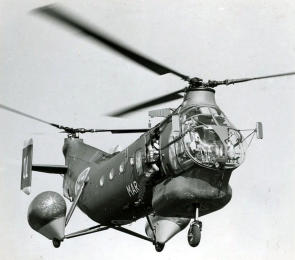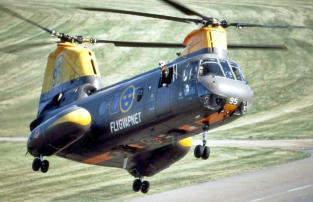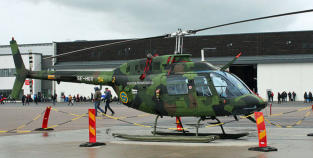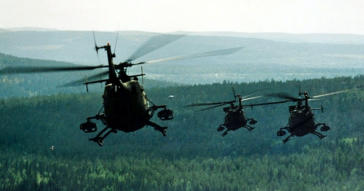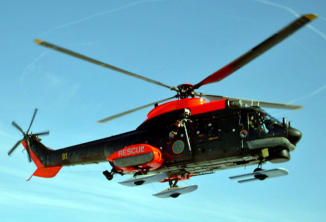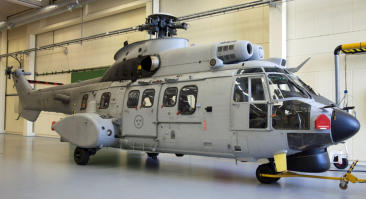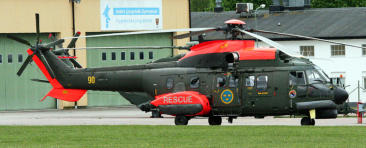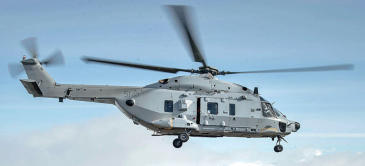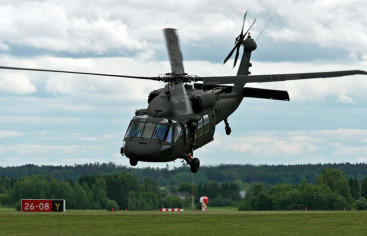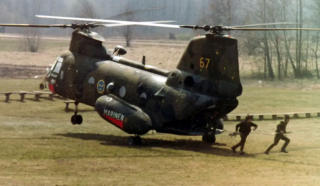

Copyright © Hans Högman 2024-06-04


Helicopters in the Swedish
Armed Forces
List of Swedish Helicopters
1.
Helikopter 1 - Boeing Vertol
44A/44B, 11 in Swedish service
1958 - 1972
2.
Helikopter 2 - Sud Aviation SE 3130
Alouette II, 29 in Swedish service
1959 - 1988
3.
Helikopter 3 - Agusta Bell 204B, 24
in Swedish service 1962 - 2001
4.
Helikopter 4 - Boeing Vertol 107 II,
24 in Swedish service 1963 - 2011
5.
Helikopter 5 - Hughes
269A/Hughes 300C/Schweizer
300C, 28 in Swedish service 1962 –
2002.
6.
Helikopter 6 - Agusta-Bell 206, 32
in Swedish service 1968 – 2004.
7.
Helikopter 7 – The designation has
not been used. However, it was
intended to designate the
helicopter type that later became
hkp 4C.
8.
Helikopter 8 - The designation has
not been used. It was the
designation of a study of an armed
helicopter which then resulted in
the HKP 9A.
9.
Helikopter 9 - Messerschmitt-
Bölkow-Blohm Bo 105, 25 in
Swedish service 1987 - 2009.
10.
Helikopter 10 - Eurocopter AS332
Super Puma, 12 in Swedish service
1988 – 2015.
11.
Helikopter 11 - Agusta Bell 412HP,
5 in Swedish service 1994 – 2004.
12.
Helikopter 12 - The designation
has not been used, HKP 12 was a
study of an intended replacement
for HKP 3 which later resulted in
HKP 14.
13.
Helikopter 13 - The designation
has not been used. The Swedish
Armed Forces have never used the
number 13 for aircraft types.
14.
Helikopter 14 - NHIndustries NH90,
18 in Swedish service 2007 - ????.
15.
Helikopter 15 - Agusta A109 LUHS,
20 in Swedish service 2006 -
16.
Helikopter 16 - Sikorsky UH-60M
Black Hawk, 15 in Swedish service
2011 -
Aircraft Designations of the Swedish Air Force:
Swedish military aircraft have a designation that
has a prefix consisting of one or more letters
followed by 2 digits and ending with a suffix that is
also a letter.
The prefix indicates the type of aircraft in terms of
its use. The numbers are the model designation
and the suffixes are the version of the aircraft.
Helicopters: The prefix used for the Swedish
helicopters is hkp (short for Helikopter -
Helicopter in English).
Sometimes the full name is used, in this case,
Helikopter. So, for example, the Sikorsky Black Hawk
is listed either as Helikopter 16 (Sikorsky UH-60M
Black Hawk) or Hkp 16 in the Swedish Defense.
Helikopter 1 – Boeing Vertol 44
The Hkp 1 is a medium-lift transport helicopter
with a tandem rotor, that was manufactured
between 1949 and 1967 by the American helicopter
manufacturer Piasecki Helicopter, later Vertol.
Vertol stands for "Vertical Takeoff and Landing" and
the helicopter was designed to be used as a rescue
helicopter in Arctic conditions and was thus well
suited to cold climates.
In the Swedish Armed Forces, the helicopter was
given the military type designation Helicopter 1
(hkp 1), but it was popularly known as "The
Banana".
The Swedish Navy ordered a total of 9 Vertol 44As
and the first two helicopters were delivered in
March 1958. The helicopter was used for a variety
of applications such as anti-submarine warfare
(sonar and dropping depth charges),
minesweeping, sea search & rescue, and troop
transport.
In October 1962, while waiting for the hkp 4, the
Swedish Air Force leased 2 Vertol 44B.
The Vertol 44B
differed from the
original version by
having larger
windows on the
sides of the fuselage,
otherwise the
versions were
externally similar.
The helicopter type
served in the
Swedish Navy and
Air Force between
1958 and 1972 with
the designation Hkp
1.
The images shows Helikopter 1 (hkp 1) – Boeing
Vertol 44 (The Banana). Swedish Navy markings.
Image: Sjöhistoriska museet, ID: Fo11339.
Specifications:
•
Crew
2+1 and 15 troops
•
In Swedish service
1958 – 1972
•
Numbers in Sweden
11 (9 + 2)
•
Number produced
714
•
Length
16.0 m
•
Height
4.7 m
•
Main rotor diam.
13.4 m
•
Motor(s)
one Curtis-Wright R-1820
•
Power output
1.070 kW (1.450 hp)
•
Max. speed
204 km/h
•
Empty weight
~3,600 kg
•
Max. takeoff weight
6,515 kg
Helikopter 2 – Sud Aviation SE 3130
Alouette II
The French Aérospatiale Alouette II is a light
helicopter that was manufactured by Sud Aviation
(later Aérospatiale). The Alouette II was the first
series-produced helicopter in the world with a gas
turbine engine (half the weight of an equivalent
piston engine) and first flew in 1955. In total, almost
1.600 Alouette IIs were produced over two decades.
In Sweden, the Sud Aviotion Alouette II was given
the military designation Helicopter 2 (hkp 2) and
was used by the Swedish Navy, Air Force, and Army
Aviation.
In total, the Swedish Armed Forces acquired 29
helicopter 2s and they were in service until 1988.
The Navy was the first in the Swedish Armed Forces
to acquire Alouette II as they needed a light
helicopter to complement their heavy helicopter 1.
In early 1959, the Navy received the first 8 hkp 2,
later supplemented by five more helicopters. It was
based at Berga naval base (Stockholm) and Säve
(Gothenburg) and was used for transportation and
reconnaissance and search & rescue missions until
1985.
The Navy was the first in the Swedish Armed Forces
to acquire Alouette II
when it needed a light
helicopter to
complement its heavy
hkp 1. The Army Air
Force used 12 hkp 2
between 1959 and
1969 and the Air
Force used 11 hkp 2
between 1959 and
1988.
The image shows Helikopter 2 – Sud Aviation SE
3130 Alouette II. Swedish Navy markings. Image:
Wikipedia.
Specifications:
•
Crew
2 and 3 troops
•
In Swedish service
1959 – 1988
•
Numbers in Sweden
29
•
Number produced
1,305
•
Length
9.60 m
•
Height
3.48 m
•
Main rotor diam.
10.20 m
•
Empty weight
895 kg
•
Max. takeoff weight
1,600 kg
•
Motor(s)
Turbomeca 1C
•
Power output
360hp
•
Max. speed
160 km/h
Helikopter 3 - Agusta Bell 204B
Helicopter 3, hkp 3, was the Swedish Armed
Forces' military designation for the Bell 204B and
was manufactured under license by Agusta. It was a
medium-lift helicopter that was procured for both
the Air Force and the Army Aviation as hkp 3A.
It soon became apparent that there were engine
problems with the hkp 3A, so a stronger engine was
fitted to all helicopter variants. Subsequently, the
designation hkp 3B was used. The Army later chose
to also modify its hkp 3 with a larger main rotor (48-
foot against the original 44-foot) to improve speed
performance and maneuverability and increase the
maximum take-off weight. This variant was
designated hkp 3C.
A total of 23 hkp 3 were acquired and were in
service until 2001. The role hkp 3 had in the
Swedish Air Force as a search & rescue helicopter
(FRÄD) was taken over by helicopter 10 and the role
hkp 3 had in the Army Aviation as a medium-lift
transport helicopter was taken over by helicopter
11.
Between 1962 and 1963, the Swedish Air Force
acquired seven hkp 3A for local air rescue, the
helicopters were later modified to hkp 3B. The
helicopters were in service with the Air Force until
1997 when the remaining helicopter individuals
were transferred to the newly formed unit, the
Helicopter Wing.
Between 1962 and 1963, Army Aviation procured
six hkp 3As and in 1964 six hkp 3Bs were procured.
These were converted between 1967 and 1968 to
hkp 3C. In 1969, three hkp 3C were acquired and in
1991 another hkp 3C was purchased from the
Austrian Air Force.
The helicopter was mainly procured for various
forms of transportation missions for the Army. In
1998, a joint Armed Forces helicopter unit
(Helicopter Wing) was created by merging the
various helicopter resources in the Armed Forces.
As a result of this, the Air Force's six remaining hkp
3Bs and the Army Air Forces' nine remaining hkp
3Cs were transferred to the Helicopter Wing. In this
organization, hkp 3 continued to be used as a
transport
helicopter and
was in service
until 2001.
The image shows
Helikopter 3 –
Agusta Bell 204B.
Swedish Air Force
markings. Image: Wikipedia.
Specifications:
•
Crew
1 - 2 and 8 - 9 troops
•
In Swedish service
1962 – 2001
•
Numbers in Sweden
23
•
Number produced
??
•
Length
17.3 m
•
Height
3.3 m
•
Main rotor diam.
16.1 m
•
Empty weight
2,400 kg
•
Max. takeoff weight
4,310 kg
•
Motor(s)
3A: 1 TM 2 A (Rolls Royce Gnome H 1000 Mk 510)
3B/C: 1 TM 2 B (Bristol Siddeley Gnome H 1200
Mk 610)
•
Power output
TM 2 A: 1.000 hk, TM 2 B:
1.250 hk
•
Max. speed
180 km/h
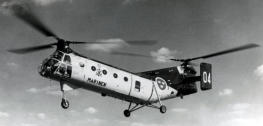
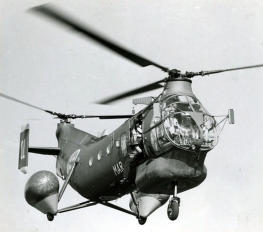

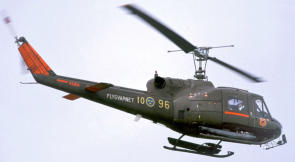
Helicopters in the Swedish
Armed Forces - 1
Helikopter 4 – Boeing Vertol 107 II
The Boeing Vertol 107 (BV 107) is a medium-lift
tandem-rotor helicopter originally developed by the
American helicopter manufacturer Vertol and has
been used by the United States Armed Forces as a
transport helicopter. The helicopter has also been
used by the Swedish Armed Forces, mainly for anti-
submarine warfare (ASW).
In 1956, Vertol began development of the V-107, first
flying it in 1958. In 1960, the company was bought by
Boeing and renamed Boeing Vertol.
In the United States Armed Forces, it went by the
military designation CH-46 Sea Knight.
In Sweden, the helicopter was given the military
designation Helikopter 4 (HKP 4) and has been used
by the Air Force and Naval Aviation. Deliveries of
helicopters began in 1963 and a total of 22 HKP 4s
were procured.
All ten Air Force helicopters, as well as the first four
for the Navy, were manufactured by Boeing Vertol (BV
107) and given the military designation HKP 4A and
HKP 4B respectively. The Naval Aviation later
purchased eight more now manufactured by
Kawasaki (KV 107) and these were designated HKP 4C
(initially the intention was to designate the KV 107 as
HKP 7, but it eventually became HKP 4C instead. Four
of the Air Force HKP 4As were later modified to HKP
4B and transferred to the Naval Aviation.
HKP 4 in the Air Force:
The Air Force had 10 HKP 4s, which were mainly used
as a search and rescue helicopter. When these were
gradually replaced by the HKP 10, four of the Air Force
HKP 4As were modified to 4Bs and transferred to the
Naval Aviation. The
Air Force HKP 4 was
based at F 8 (1963
to 1964 stationed at
Berga), F 15, F 17
and F 21 and was in
service with the Air
Force until 1992.
The image shows
Helikopter 4A – Boeing Vertol 107. Swedish Air Force
markings. Image: Wikipedia.
HKP 4 in Naval Aviation:
The Naval Aviation had 16 HKP 4s, four of which
originally came from the Air Force. The helicopter was
used in Naval Aviation mainly for anti-submarine
warfare and could be equipped with dipping sonar
and six depth charge 51s or two torpedo 45s.
Furthermore, the helicopter could be equipped with a
radar for reconnaissance of surface targets.
HKP 4 was in service in the Naval Aviation until 1998
when the remaining
helicopter
individuals were
transferred to the
newly formed unit
Helicopter Wing.
The image shows
Helikopter 4B –
Boeing Vertol 107. Swedish Navy markings. Image:
Garnisonsmuseet Skaraborg, ID: GMSF.037189.
HKP 4 in the Helicopter Wing:
In 1998, a joint Armed Forces helicopter unit
(Helicopter Wing) was created by merging the various
helicopter resources in the Armed Forces, including
the Naval Aviation. As a result, the remaining 14 HKP
4s of the Naval Aviation were transferred to the
Helicopter Wing.
In this organization, HKP 4 was primarily used as a
transport helicopter, and in 2008 it was on standby
for the Nordic Battlegroup rapid reaction force. HKP 4
was in service with the Helicopter Wing until 2011.
In practice, the operation of HKP 4 within the Armed
Forces ceased in 2008, and in 2010 the decision was
taken to decommission it.
Specifications:
•
Crew
3-5 and 26 troops
•
Number produced
524 (H-46)
•
Numbers in Sweden
24
•
In Swedish service
1963 – 2011
•
Total length
25.5 m
•
Fuselage length
13.66 m
•
Main rotor diam.
15.24 m
•
Height
5.11 m
•
Empty weight
4,900 kg
•
Max. takeoff weight
11,022 kg
•
Motor(s)
Two General Electric T58-
GE-16
•
Power output
2 x 1870 hp
•
Max. speed
270 km/h
Helikopter 5 - Hughes 269A/Hughes
300C/Schweizer 300C
The Hughes 269 is a light piston engine helicopter
manufactured by Hughes Helicopters. In series
production, it was designated the Hughes 269A. In
1964, a slightly larger model called the Hughes 300
(sometimes also called the Hughes 269B) was
launched. In 1969, a more powerful model called the
Hughes 300C (sometimes also called the Hughes
269C) was introduced. In 1983, Schweizer Aircraft
began licensed production of the Hughes 300C. In
2004, Sikorsky Aircraft bought Schweizer. In 2009, the
model was renamed Sikorsky S-300C.
Helikopter 5 (hkp 5) was the Swedish Armed Forces'
designation for the Hughes 269A and later the
Hughes 269C/Schweizer 300C. The helicopter was
mainly used for basic flight training. Within the
Swedish Armed Forces, the hkp 5 was sometimes
jokingly called “pisskuren” (small urinal), referring to
how small it was.
In 1962, the Army acquired two Hughes 269As (hkp
5A), for evaluation in areas such as reconnaissance
and fire control. At the end of the 1970s, the Armed
Forces were looking for a replacement for the aircraft
used in basic flight training. The choice fell on the
Hughes 269C (hkp 5B) delivered in 1980 - 1982 and
the Schweizer 300C delivered in 1985 - 1987. A total of
26 helicopters were delivered.
When the Helicopter Wing was formed in 1998 as a
joint helicopter unit of the Swedish Armed Forces, the
Army Aviation's remaining 25 hkp 5B were transferred
to the Helicopter
Wing. Here, Hkp 5B
continued to be
used for basic flight
training and was in
service until 2002.
Hkp 5B was
replaced by helicopter 15.
The image shows Helikopter 5B – Hughes 269C.
Image: Wikipedia.
Specifications:
•
Crew
1+1
•
Number produced
3.500+
•
Numbers in Sweden
28 st
•
In Swedish service
1962 – 2002
•
Length
6.8 m
•
Height
2,.5 m
•
Main rotor diam.
7.7 m
•
Empty weight
~580 kg
•
Max. takeoff weight
930 kg
•
Motor(s)
Lycoming HIO-360 (piston
engine)
•
Power output
132 kW (180 hp)
•
Max. speed
140 km/h
Helikopter 6 - Agusta-Bell 206
Helikopter 6 (hkp 6) was the Swedish Armed Forces'
military designation for the Bell 206, which was
manufactured under license by (then) Agusta. Hkp 6 is
a light-lift helicopter that was acquired to replace
the hkp 2 in both the Army and the Navy. Helicopter 6
was available in two variants, hkp 6A (Army) and hkp
6B (Navy).
A total of 32 hkp 6 were procured and were in service
until 2004. Hkp 6 was replaced by Helikopter 15.
Starting in 1968, delivery of 22 hkp 6A to the then
Artillery Aviation began. The helicopter was mainly
used as a light transport helicopter and for (tactical)
flight training.
10 hkp 6B was acquired for the then Naval Aviation.
The helicopter was used as a light transport
helicopter and for anti-submarine warefare as it could
be equipped with anti-submarine torpedoes. The
helicopter also had inflatable floats that allowed
emergency landings on water.
In 1998, hkp 6 was
transferred to the
then newly formed
Helicopter Wing
and used as a
transport
helicopter. Here it
was in service until 2004.
The image shows Helikopter 6B – Agusta-Bell.
Swedish markings. Image: Wikipedia.
Specifications:
•
Crew
1 + 4 passengers
•
Number produced
??
•
Numbers in Sweden
32 (22 hkp 6A and 10 hkp
6B)
•
In Swedish service
1968 – 2004
•
Length
8.7 m
•
Height
3.5 m
•
Main rotor diam.
10.2 m
•
Empty weight
~925 kg
•
Max. takeoff weight
1,500 kg
•
Motor(s)
Allison 250-C20
•
Power output
233 kW (317 hp)
•
Max. speed
165 km/h (90 knots)
•
Transport range
330 km
Helikopter 9 - Messerschmitt-Bölkow-Blohm
Bo 105
The Messerschmitt-Bölkow-Blohm Bo 105 is a light
helicopter that Bölkow began developing in the mid-
1960s. The BO 105 is characterized by its semi-rigid
main rotor system, which makes the helicopter very
maneuverable, and capable of advanced maneuvers
such as looping.
Helikopter 9 (hkp 9) was the Swedish Armed Forces
type designation for the MBB Bo 105. Hkp 9 existed in
two versions, hkp 9A (Army Aviation, FMV, and
Helicopter Wing) and hkp 9B (Air Force), and was in
service until 2009.
In 1987, the Swedish Army Aviation acquired 20 hkp
9A and the FMV one hkp 9A (Bo 105CB3). The
helicopter could be armed with the HeliTOW anti-
tank missile system. The Army Aviation's hkp 9A had
the wartime task of conducting anti-tank
operations.
As early as 1976, the Army began trials with anti-tank
helicopters, when two hkp 6s were equipped with
gyro-stabilized sights and target-marking video
cameras. In the fall of 1980, anti-tank helicopter trials
began with different types of helicopters at the
Norrbotten Army Aviation Battalion (AF 1). While
waiting for the twenty serial helicopters to be
delivered, FMV hired four interim helicopters (Bo
105CB) from MBB. One of them was used for testing
the weapon system, which mainly took place at RFN
(Vidsel). One of the helicopters was later purchased
and became the 21st hkp 9A.
Delivery of the serial helicopters (Bo 105CB3) took
place between October 1987 and November 1988 at a
rate of one to three helicopters per month. After
flying home to Sweden, the weapon system was fitted
(which was supplied by Saab). Hkp 9A was equipped
with the RBS 55H
(Saab HeliTOW)
weapon system,
which was based on
missile 55 (TOW).
The image shows
Helikopter 9A -
Messerschmitt-
Bölkow-Blohm Bo 105 CBS. Swedish markings. Photo:
Peter Langsdale. Image: Aeroseum, ID: AERO.002207.
The twenty helicopters formed two anti-tank
helicopter companies.
Hkp 9A was in service in the Army Aviation until 1997,
when the remaining helicopter individuals were
transferred in 1998 to the newly formed unit
Helicopter Wing.
In 1985, the Swedish Air Force acquired 4 hkp 9B (Bo
105CB4) to replace hkp 2. The helicopter was used for
local air search and rescue. The helicopter was
equipped with a winch to be able to pick up people in
distress without landing the helicopter.
In 1998, the Army Aviation's remaining 19 hkp 9A was
transferred to the Helicopter Wing. Here, hkp 9A was
given a new role as a transport helicopter and was in
service until 2009.
Hkp 9A was (indirectly) replaced by Hkp 15.
Specifications:
•
Crew
2 and 3 passengers
•
Number produced
1.640+
•
Numbers in Sweden
21 hkp 9A and 4 hkp 9B
•
In Swedish service
1987 – 2009
•
Total length
11.86 m
•
Fuselage length
8.81 m
•
Height
3.00 m
•
Main rotor diam.
9.84 m
•
Empty weight
~1,300 kg
•
Max. takeoff weight
2,500 kg
•
Motor(s)
Two Allison 250-C20B turbine
engines
•
Power output
2 × 298 kW (2 × 420 hp)
•
Max. speed
242 km/h
•
Armament
Four RBS 55H (Saab HeliTOW)
Images of hkp 9:

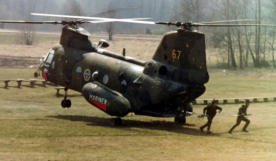
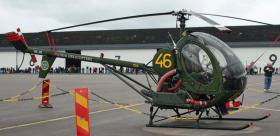
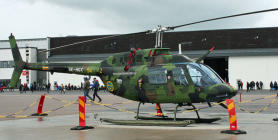
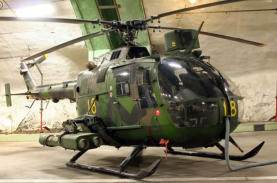
Helikopter 10 - Eurocopter AS332 Super Puma
The Eurocopter AS332 Super Puma (now Airbus
Helicopters H215) is a medium-lift helicopter.
In the Swedish Armed Forces, the AS332 Super Puma
was given the military designation Helikopter 10
(hkp 10A) and has been used by the Swedish Air
Force and later by the Swedish Helicopter Wing
mainly for regional military air search and rescue
(SAR).
Between 1988 and 1991, 10 hkp 10A were acquired.
Between 1994 and 1995, a further 2 hkp 10A were
acquired.
The first two hkp 10As delivered were interim
helicopters with limited technical capabilities. The
'live' version of the hkp 10A was delivered between
1990 and 1991, while the two interim helicopters
were modified to serial status between 1990 and
1992.
Initially, the crew consisted of two pilots, a flight
engineer, and a (conscripted) rescue swimmer (Swe:
ytbärgare). But soon it was realized that the
helicopter's potential as an "all-weather machine"
could not be fully exploited unless there was also a
navigator, as there had been on the hkp 4A.
The hkp 10B was a modification of the 10A version
whose purpose was to be able to operate in
international operations as a MEDEVAC resource by
increasing the helicopter's self-protection/survivability
in an elevated threat environment.
In 2010, the helicopter operations at Sjöfartsverket -
the Swedish Maritime Administration - took over
the Aerial Search & Rescue readiness completely from
the Armed Forces. This
changed the role of hkp
10 from being a SAR
helicopter to a more
purely transport
helicopter. Hkp 10 was
in service in the
Helicopter Wing until
2015.
The image shows Helikopter 10A - Eurocopter AS332
Super Puma. Fin number: 91. Swedish markings.
Photo in 2004. Image: Wikipedia.
Specifications:
•
Crew
5 (Ordinary crew)
•
Numbers in Sweden
12
•
In Swedish service
1988 – 2015
•
Length
16.29 m
•
Height
4.6 m
•
Main rotor diam.
15.6 m
•
Empty weight
4,460 kg
•
Max. takeoff weight
9,000 kg (interior load)
•
Motor(s)
Two Turboméca Makila
1A2
•
Power output
1,357 kW (1,819 hp)
•
Max. speed
278 km/h
Images of hkp 10:
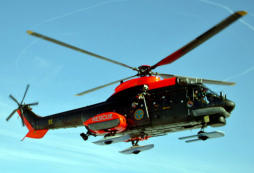
Helikopter 11 - Agusta Bell 412HP
The first version of the helicopter was called 412
(Basic). This was followed by the 412SP (Special
Performance), 412HP (High Performance), 412EP
(Extended Performance), and 412EPI (Extended
Performance Integrated avionics).
Helikopter 11 (hkp 11) was the Swedish Armed
Forces' type designation for the Agusta-Bell 412HP
and was used (initially) as an ambulance helicopter
and then as a transport helicopter. Hkp 11 was in
service until November 29, 2004.
When the order for 5 hkp 11 was placed, an
Ambulance Helicopter Company was established in
1993 at AF 1 (Army Aviation) in Boden. All hkp 11 were
delivered in 1994.
In 1995, the Ambulance Helicopter Company was
reorganized into a platoon of the Transport Helicopter
Company. This meant that ambulance operations were
no longer the main task of the hkp 11; instead, the
helicopter was used as a transport helicopter. Among
other things, the helicopter was intended to be able to
transport seven ranger soldiers (a group) with
equipment or carry out
military medical
transportation of six
stretchers with
wounded.
The image shows
Helikopter 11 - Agusta Bell 412HP. Fin number: 31.
Swedish markings. Photo in 2004. Image: Wikipedia.
Specifications:
Crew
2 and 13 troops
Number produced
900+
Numbers in Sweden
5
In Swedish service
1994 – 2004
Length
12.70 m
Height
3.48 m
Main rotor diam.
14.00 m
Empty weight
3,079 kg
Max. takeoff weight
5,397 kg
Motor(s)
Two Pratt & Whitney 6T-3Be Tam11
Power output
2 x 671 kW
Max. speed
259 km/h
Helikopter 14 - NHIndustries NH90
The NHIndustries NH90 is a medium-lift, multirole
military helicopter and the world's first mass-
produced helicopter to feature entirely fly-by-wire
flight controls (FBW) - a system that replaces the
conventional manual flight controls of an aircraft with
an electronic interface -, and a full composite fuselage.
The helicopter is a joint project between four
European NATO countries and is manufactured by
NHIndustries. The development of the NH90 started in
1993. The first flight was made in the fall of 1995.
The NH90 was developed in two main variants; TTH
(Tactical Transport Helicopter) for land operations and
NFH (NATO Frigate Helicopter) for sea operations.
•
The TTH is a land-based operational model
primarily intended for TTT - Tactical Troop
Transports - (up to 20 troops) and material as well
as missions such as medical evacuation (up to 12
stretcher cases), search and rescue missions (SAR)
and support for special operations. The helicopter
can also be used in difficult weather conditions
(including icing) and during all hours of the day
(day/darkness).
•
The NFH is a maritime operational model that is
technically adapted to land on ships and is based
on board frigates and other large vessels. It is
primarily intended for anti-submarine warfare
(ASW) and air-to-surface combat, but can also
perform all the tasks that the TTH can.
Both of the two main variants are available in several
different sub-variants.
In 2001, Sweden ordered 18 NH90 TTHs, even
though the Swedish Defense Materiel Administration
(FMV) recommended the Blackhawk from Sikorsky,
which they considered more affordable.
The Swedish designation is Helikopter 14 (hkp 14).
In 2007, the first Swedish NH90 was delivered, two
years delayed. This was a land-based operational
helicopter. This was the first series-produced NH90
delivered to an export customer (outside NAHEMA).
The first Swedish maritime operational NH90 was
delivered in 2015. It was not until 2019 that all
Swedish NH90s were delivered, ten years later than
the original plan.
Of the 18 NH90 TTHs ordered by Sweden, 9 are
purely land operative and are known in the Swedish
Armed Forces as hkp 14E. The remaining 9 are
maritime operational and are known as hkp 14F and
are equipped with sonar equipment and tactical radar
for use in anti-submarine warfare (ASW). The Swedish
order also included an increased working height in the
cabin, from 157 cm to 182 cm. This modification is
now marketed by the manufacturer as HCV (High
Cabin Version).
The hkp 14 is equipped with a Saab-developed Tactical
Mission System.
The Swedish Armed Forces' hkp 14 has suffered
many problems, and delays. The operating cost is
also very high. A Black Hawk (hkp 16) has an operating
cost of about 30,000 - 40,000 SEK/h while hkp 14 has
an operating cost of 200,000 SEK/h.
With expensive flying hours, lack of spare parts and
noise problems, the Swedish Armed Forces
announced in December 2022 that they want to
abolish the hkp 14
system prematurely
and replace it with 12
Sikorsky Black Hawk and 9
Sea Hawk (maritime
operational). The
decision is in line with
the recommendations made in the helicopter
investigation earlier this fall.
The image shows Helikopter 14F - NHIndustries
NH90 TTH (HCV). Swedish markings. Photo: Lasse
Jansson. Image: Swedish Armed Forces.
Specifications:
•
Crew
1 pilot + other crew depending on
the mission.
•
Number produced
515 (mars 2024)
•
Numbers in Sweden
18
•
In Swedish service
2007 - ????
•
Length
19.6 m
•
Fuselage length
16.2 m
•
Height
5.4 m
•
Main rotor diam.
16.3 m
•
Empty weight
5,750 kg
•
Max- takeoff weight
10,600 kg
•
Motor(s
)
2 x Rolls-Royce Turbomeca RTM
322 01/9
•
Power output
2 x 1,662 kW
•
Max. speed
324 km/h
•
Max. altitude
6.000 m
•
Armament
Door-mounted machine gun if
needed
Images:
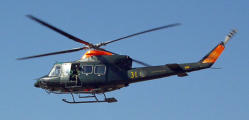
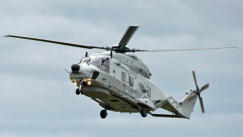
Helikopter 15 - Agusta A109 LUHS
The Leonardo AW109, formerly the AgustaWestland
AW109 and Agusta A109, is a light transport
helicopter whose production started in the mid-
1970s.
Helicopter 15 (hkp 15) is the Swedish Armed Forces'
designation for the AgustaWestland AW109 LUHS
(Light Utility Helicopter System), which is a military
variant of the AW109.
Sweden ordered 20 hkp 15 and is available in two
versions; 12 land operational hkp 15A and 8
maritime operational hkp 15B.
The difference between the two versions is that the
hkp 15B can be equipped with anti-submarine warfare
equipment. The hkp 15B can also be temporarily
based on Visby-class corvettes, which are equipped
with helicopter decks. Visually, there is a difference
between the two versions as the hkp 15A is painted
green camouflage while the hkp 15B is painted
gray.
The hkp 15 can accommodate two pilots and six
passengers and can be fitted with a range of
equipment depending on the type of mission it is to
undertake. The hkp 15A was due to be delivered in
2005, but delivery was delayed until September 2006.
Hkp 15B was delivered in April 2008.
During the period April to November 2010, two
Swedish hkp 15B participated in Operation Atalanta
(ME02) in the Gulf of Aden. One helicopter was based
on board the Swedish HMS Carlskrona (P04) and the
other was based at the French base in Djibouti as a
reserve. The helicopter
on board HMS
Carlskrona was a form
of rapid reaction force
against suspected pirate
ships and also served as
a reconnaissance resource.
The image shows Helikopter 15B - Agusta A109 LUHS.
Swedish markings. Fin number: 33. Photo in 2010 at
Malmen, Linköping. Image: Wikipedia.
Specifications:
•
Crew
2 + 6 passengers
•
Numbers in Sweden
20 (12 hkp 15A+ 8 hkp 15B)
•
In Swedish service
2006 –
•
Length
11.4 m
•
Height
3.5 m
•
Main rotor diam.
11.0 m
•
Empty weight
2,250 kg
•
Max. takeoff weight
3,175 kg
•
Motor(s)
Two Turbomeca Arrius 2K2
•
Power output
2 × 797 hp
•
Max. speed
310 km/h
•
Max. altitude
5.600 m
•
Armament
If necessary, machine gun
M58 and act as a sniper platform
Images:
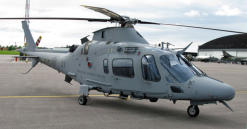
Helikopter 9A - Messerschmitt-Bölkow-Blohm Bo
105. Attack/anti-tank helicopter equipped with the
anti-tank missile weapon system. Image:
Flygvapenmuseum, ID: FVM.142922.
Helikopter 9A - Messerschmitt-Bölkow-Blohm Bo
105. Equipped with the anti-tank missile weapon
system. Image: Wikipedia.
Hkp 10A - Eurocopter AS332 Super Puma. Fin
number: 90. Swedish markings. Photo 2007. Image:
Wikipedia..
Hkp 10B – Eurocopter AS332 Super Puma. Fin
number: 98. Swedish markings. Image:
Flygvapenmuseum, ID: FVM.152893.
Hkp 14F - NHIndustries NH90 TTH (HCV). Swedish
markings. Image: Försvarsmakten.
Hkp 14E - NHIndustries NH90 TTH (HCV). A pair of
Swedish hkp 14E in 2012. Image: Wikipedia.
Helikopter 15A - Agusta A109 LUHS. Swedish
markings. Fin number: 25. Photo in 2012. Image:
Wikipedia.
Helikopter 15B - Agusta A109 LUHS. Swedish
markings. Fin number: 30. The helicopter hovers over
the corvette HMS Visby's helideck. Photo Joakim
Johansson. Image: FMV.

Helikopter 16 - Sikorsky UH-60M Black Hawk
Sikorsky UH-60 Black Hawk is the US Armed Forces
designation for the military variant of the Sikorsky S-
70, which is a medium-lift utility helicopter.
The UH-60 comes in a range of basic versions,
designated by a letter suffix after "60", of which the
UH-60M is the latest.
Sweden has 15 UH-60Ms, which are designated
Helikopter 16 (hkp 16) in the Swedish Armed Forces.
The delivery and introduction of Helicopter 14 (hpp 14
- NH90) was delayed by many years (in the early
2000s) at the same time as the need for helicopters,
especially for medical transport (Medevac), increased
in the Swedish defense's areas of operation. In view
of this, the military helicopter inquiry proposed in its
final report that Sweden should acquire an additional
15 medium-lift helicopters. In January 2011, the
Swedish Defense Materiel Administration (FMV)
announced that the Sikorsky UH-60M had been
selected. However, these 15 UH-60M (hkp 16) were
not purchased by the manufacturer Sikorsky, but by
the US Army. As the purchase was made between two
states, the Public Procurement Act did not have to be
considered and deliveries could be made quickly. The
first two helicopters were delivered in December
2011 and the system was finally delivered in April
2013.
The main task of the helicopter system is to support
the Armed Forces with troop and material
transportation. Helikopter 16 / Black Hawk can be
equipped with a warning and countermeasures
system (VMS), as well as ballistic protection (EBPS).
Furthermore, sand filters on the engines' air intakes
(EIBF) can be fitted, and winch and two machine guns
of model M240 H.
At the end of May 2024, the US Department of
Defense announces that it has approved the sale of
12 UH-60M Blackhawk helicopters to Sweden for a
value of SEK 9.6 billion. Along with the helicopters,
advanced equipment is also delivered.
The Blackhawk helicopters are to replace both the
troubled hkp 14 (NH 90) and the older hkp 15 as a
land operational helicopter. Sweden is also planning
to purchase 9 Seahawk
maritime helicopters to
replace the hkp 14's
maritime operations.
The image shows
Helikopter 16 Black
Hawk at Gärdet in Stockholm in 2013. Image:
Wikipedia.
Specifications, hkp 16:
•
Crew
2-4
•
Number produced
4.000+ (Jan. 2016)
•
Numbers in Sweden 15 (Jan. 2024)
•
In Swedish service 2011 -
•
Length
19.76 m
•
Height
5.13 m
•
Main rotor diam.
16.36 m
•
Empty weight
4,819 kg
•
Max. takeoff weight
11,113 kg
•
Motor(s)
Two General Electric T700-GE-
701D
•
Power output
1.492 kW
•
Max. speed
357 km/h
•
Max. altitude
5,790 m
•
Cannons / machine guns:
Two 7.62mm M240H machine guns or two GE
Minigun-M134
Images:

Helikopter 16 Black Hawk at Malmen, Linköping, June
2012. Image: Wikipedia.
Helikopter 16 Black Hawk at Malmen, Linköping, June
2012. Image: Wikipedia.
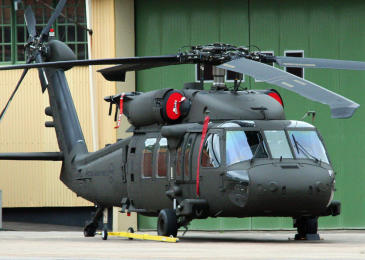

Helikopter 16 - Sikorsky UH-60M Black Hawk
Sikorsky UH-60 Black Hawk is the US Armed Forces
designation for the military variant of the Sikorsky S-
70, which is a medium-lift utility helicopter.
The UH-60 comes in a range of basic versions,
designated by a letter suffix after "60", of which the
UH-60M is the latest.
Sweden has 15 UH-60Ms, which are designated
Helikopter 16 (hkp 16) in the Swedish Armed Forces.
The delivery and introduction of Helicopter 14 (hpp 14
- NH90) was delayed by many years (in the early
2000s) at the same time as the need for helicopters,
especially for medical transport (Medevac), increased
in the Swedish defense's areas of operation. In view
of this, the military helicopter inquiry proposed in its
final report that Sweden should acquire an additional
15 medium-lift helicopters. In January 2011, the
Swedish Defense Materiel Administration (FMV)
announced that the Sikorsky UH-60M had been
selected. However, these 15 UH-60M (hkp 16) were
not purchased by the manufacturer Sikorsky, but by
the US Army. As the purchase was made between two
states, the Public Procurement Act did not have to be
considered and deliveries could be made quickly. The
first two helicopters were delivered in December
2011 and the system was finally delivered in April
2013.
The main task of the helicopter system is to support
the Armed Forces with troop and material
transportation. Helikopter 16 / Black Hawk can be
equipped with a warning and countermeasures
system (VMS), as well as ballistic protection (EBPS).
Furthermore, sand filters on the engines' air intakes
(EIBF) can be fitted, and winch and two machine guns
of model M240 H.
At the end of May 2024, the US Department of
Defense announces that it has approved the sale of
12 UH-60M Blackhawk helicopters to Sweden for a
value of SEK 9.6 billion. Along with the helicopters,
advanced equipment is also delivered.
The Blackhawk helicopters are to replace both the
troubled hkp 14 (NH 90) and the older hkp 15 as a
land operational helicopter. Sweden is also planning
to purchase 9 Seahawk
maritime helicopters to
replace the hkp 14's
maritime operations.
The image shows
Helikopter 16 Black
Hawk at Gärdet in Stockholm in 2013. Image:
Wikipedia.
Specifications, hkp 16:
•
Crew
2-4
•
Number produced
4.000+ (Jan 2016)
•
Numbers in Sweden 15 (Jan. 2024)
•
In Swedish service 2011 -
•
Length
19.76 m
•
Height
5.13 m
•
Main rotor diam.
16.36 m
•
Empty weight
4,819 kg
•
Max. takeoff weight
11,113 kg
•
Motor(s)
Two General Electric T700-GE-
701D
•
Power output
1.492 kW
•
Max. speed
357 km/h
•
Max. altitude
5,790 m
•
Cannons / machine guns:
Two 7.62mm M240H machine guns or two GE
Minigun-M134
Images:








